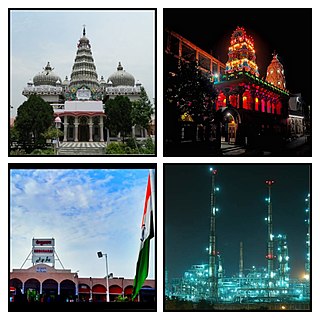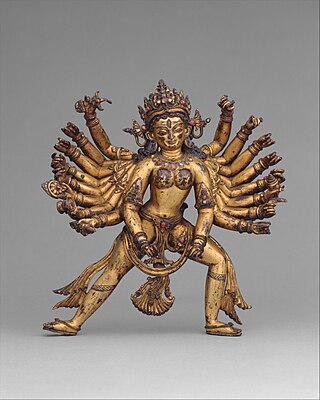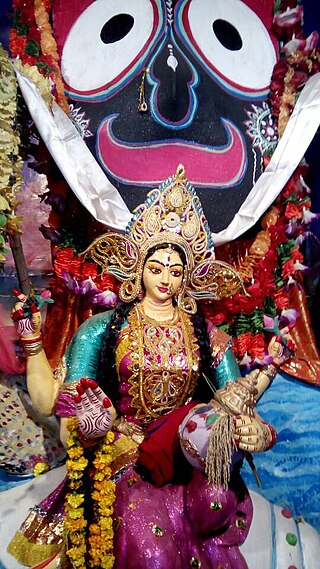
Lakshmi, also known as Shri, is one of the principal goddesses in Hinduism. She is the goddess of wealth, fortune, power, beauty, fertility and prosperity, and associated with Maya ("Illusion"). Along with Parvati and Saraswati, she forms the Tridevi of Hindu goddesses.

Diwali is the Hindu festival of lights with its variations also celebrated in other Indian religions. It symbolises the spiritual "victory of light over darkness, good over evil, and knowledge over ignorance". Diwali is celebrated during the Hindu lunisolar months of Ashvin and Kartika—between around mid-September and mid-November. The celebrations generally last five or six days.

Begusarai is the industrial and financial capital of Bihar and the administrative headquarters of the Begusarai district, which is one of the 38 districts of the Indian state of Bihar. The district lies on the northern bank of the river Ganges in the Mithila region of India.

Chhath is an ancient Hindu festival historically native to the Indian subcontinent, more specifically, the Indian states of Bihar, Uttar Pradesh, Madhya Pradesh, Jharkhand, West Bengal and the Nepalese provinces of Madhesh and Lumbini. Prayers during Chhath puja are dedicated to the solar deity, Surya, to show gratitude and thankfulness for bestowing the bounties of life on earth and to request that certain wishes be granted.

Amāvásyā is the lunar phase of the new moon in Sanskrit. Indian calendars use 30 lunar phases, called tithi in India. The dark moon tithi is when the Moon is within 12 degrees of the angular distance between the Sun and Moon before conjunction (syzygy). The New Moon tithi is the 12 angular degrees after syzygy. Amāvásyā is often translated as new moon since there is no standard term for the Moon before conjunction in English.

Ekadashi is the eleventh lunar day (tithi) of the waxing and waning lunar cycles in a Vedic calendar month. Ekadashi is popularly observed within Vaishnavism and Shaivism, two major paths within Sanatan Dharma. Followers offer their worship to the god Vishnu, Shiva by fasting or just as symbol, the idea was always to receive self discipline and benefits of fasting and it was connected to the way if life via Sanatam Dharma practices.

Dashain or Bada'dashain, also referred as Vijaya Dashami in Sanskrit, is a major Hindu religious festival in Nepal and the Indian states of Sikkim and West Bengal. It is also celebrated by Hindus of Nepal and elsewhere in the world, including among the Lhotshampa of Bhutan and the Burmese Gurkhas of Myanmar. The festival is also referred as Nauratha, derived from the Sanskrit word for the same festival Navaratri which translates to Nine Nights. A version of this festival is celebrated as Navaratri, Dussehra or Dashera by Hindus in India, although rites and rituals vary significantly.
This article lists the traditional festivals and other cultural events in the Odisha region of India. Odisha celebrates 13 festivals in 12 months as the saying goes Bāra Māsare Tera Parba.

Lakshmi Puja is a Hindu occasion for the veneration of Lakshmi, the goddess of prosperity and the supreme goddess of Vaishnavism. The occasion is celebrated on the amavasya in the Vikram Samvat Hindu calendar month of Ashwayuja or Kartika, on the third day of Deepavali in most part of India. In Assam, Bengal, and Odisha, this puja is celebrated five days after Vijaya Dashami.
Mithila culture or Maithil culture refers to the culture which originated in the Mithila region of the Indian subcontinent. Mithila comprises Tirhut, Darbhanga, Kosi, Purnia, Munger, Bhagalpur and Santhal Pargana divisions of India and adjoining provinces of Province No. 1, Bagmati Pradesh, and Madhesh Province of Nepal.

Varalakshmi Vratam, also called Varalakshmi Puja, is a Hindu observance to propitiate the goddess of wealth, Lakshmi. Varalakshmi is the manifestation of Lakshmi who grants boons (varam). It is a puja primarily performed by married Hindu women in the states of South India. This occasion is observed on the Friday before the day of the full moon - Purnima - in the Hindu month of Shravana, which corresponds to the Gregorian months of July – August.

Navaratri is an annual Hindu festival observed in honour of the goddess Durga, an aspect of Adi Parashakti, the supreme goddess. It spans over nine nights, first in the month of Chaitra, and again in the month of Ashvin (September–October). It is observed for different reasons and celebrated differently in various parts of the Hindu Indian cultural sphere. Theoretically, there are four seasonal Navaratri. However, in practice, it is the post-monsoon autumn festival called Sharada Navaratri.

Gaura Parva is a Hindu festival celebrated by the people residing in Sudurpashchim province and parts of Karnali province of Nepal as well as in Kumaon region of Uttarakhand state of India. The festival commemorates the wedding of goddess Gaura (Parvati) to Lord Shiva. The festival falls in the Hindu month of Bhadra (August/September).

Prabodhini Ekadashi, also known as Deva Uttana Ekadashi, is the 11th lunar day (ekadashi) in the bright fortnight of the Hindu month of Kartika. It marks the end of the four-month period of Chaturmasya, when the god Vishnu is believed to be asleep. It is believed that Vishnu sleeps on the day of Shayani Ekadashi, and wakes on this day.
The religious festivals of the Kashmiri Pandits have Rigvedic roots. Some festivals of Kashmiri Pandits are unique to Kashmir. Some Kashmiri Pandit festivals are Herath (Shivaratri), Navreh, Zyeath-Atham, Huri-Atham, Zarmae-Satam (Janmashtami), Dussehra, Diwali, Pan, Gaad Batt, Khetsimavas (Yakshamavasya), Kava Punim, Mitra Punim, Tiky Tsoram, Gengah Atham, Tila Atham, Vyetha Truvah, and Anta Tsodah.
Pūrṇimā is the word for full moon in Sanskrit. The day of Purnima is the day (Tithi) in each month when the full moon occurs, and marks the division in each month between the two lunar fortnights (paksha), and the Moon is aligned exactly in a straight line, called a syzygy, with the Sun and Earth. Full moon is considered the third of the four primary phases of the Moon; the other three phases are new moon, first quarter moon, and third quarter moon. The full moon shows 100% illumination, causes high tides, and can concur with lunar eclipses.
Here is a list of glossary of Culture of India in alphabetical order:

Saama Chakeba is a Hindu festival, originating from the Mithilaregion of the Indian subcontinent. It is a festival of unity. It is celebrated in November and commences when birds begin their migration from the Himalayas down towards the plains of India. According to the Hindustan Times, the festival, which includes folk theater and song, celebrates the love between brothers and sisters and is based on a legend recounted in the Puranas. It is celebrated by Maithilis and Tharu people of India and Nepal.

Chaurchan is special festival of the Mithila region of India and Nepal. It is a very important fasting for married women in Mithila. It is also known as Charchanna Pabni, Chauth Chand or Chauth Chandra or Chorchan Puja. It is dedicated to Lord Ganesha and Chandra Deva. It has a lot of religious significance. On this day, married women keep a fast. Different types of dishes are prepared as prasad. Ganesh Chaturthi fast is also observed on this day. Along with Lord Ganesha, Lord Vishnu, Goddess Parvati and the moon god is worshipped. The story of Chorchan Puja is also heard on this day after that Arghya is offered to the moon god Chandra Deva.

















